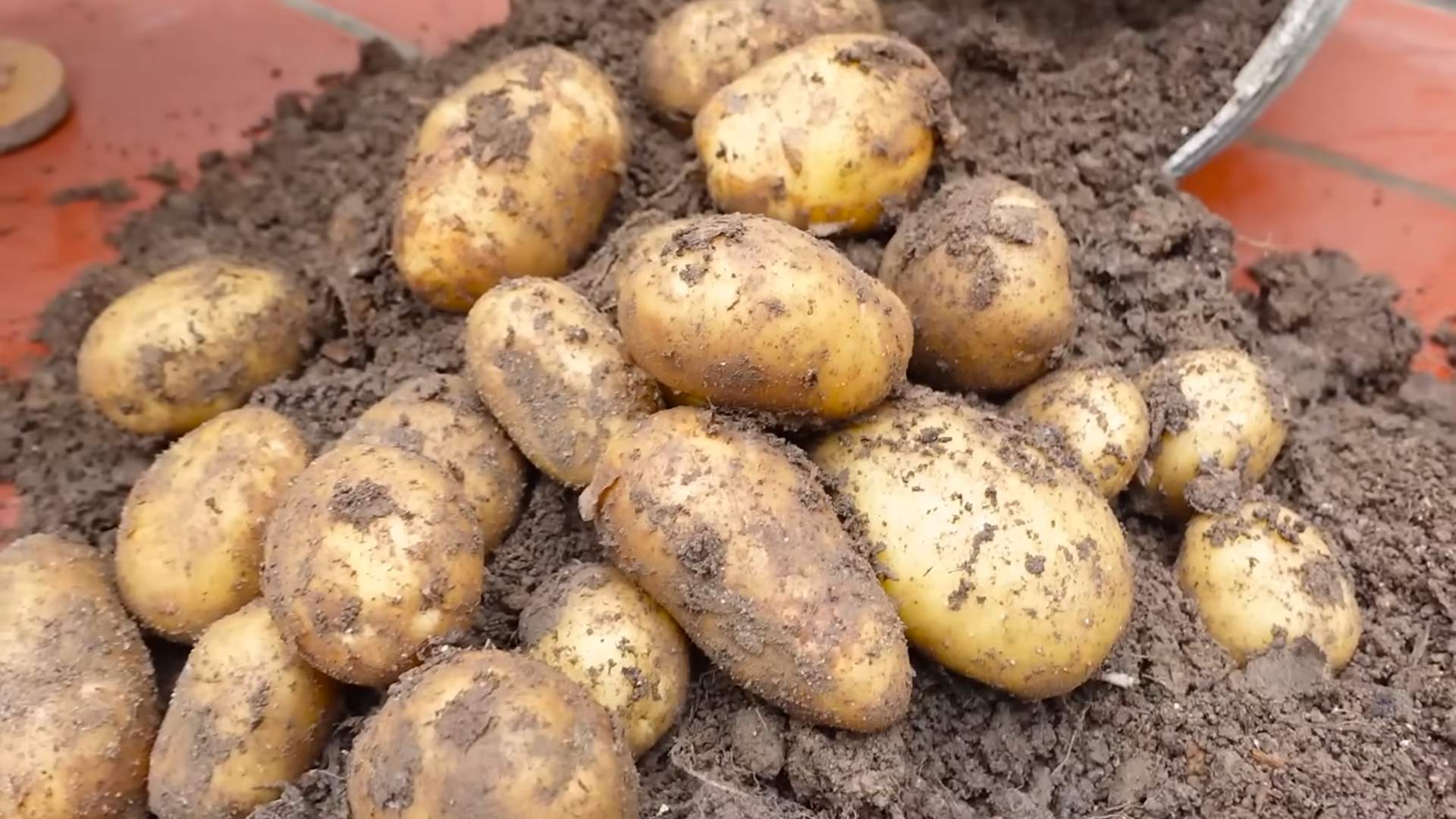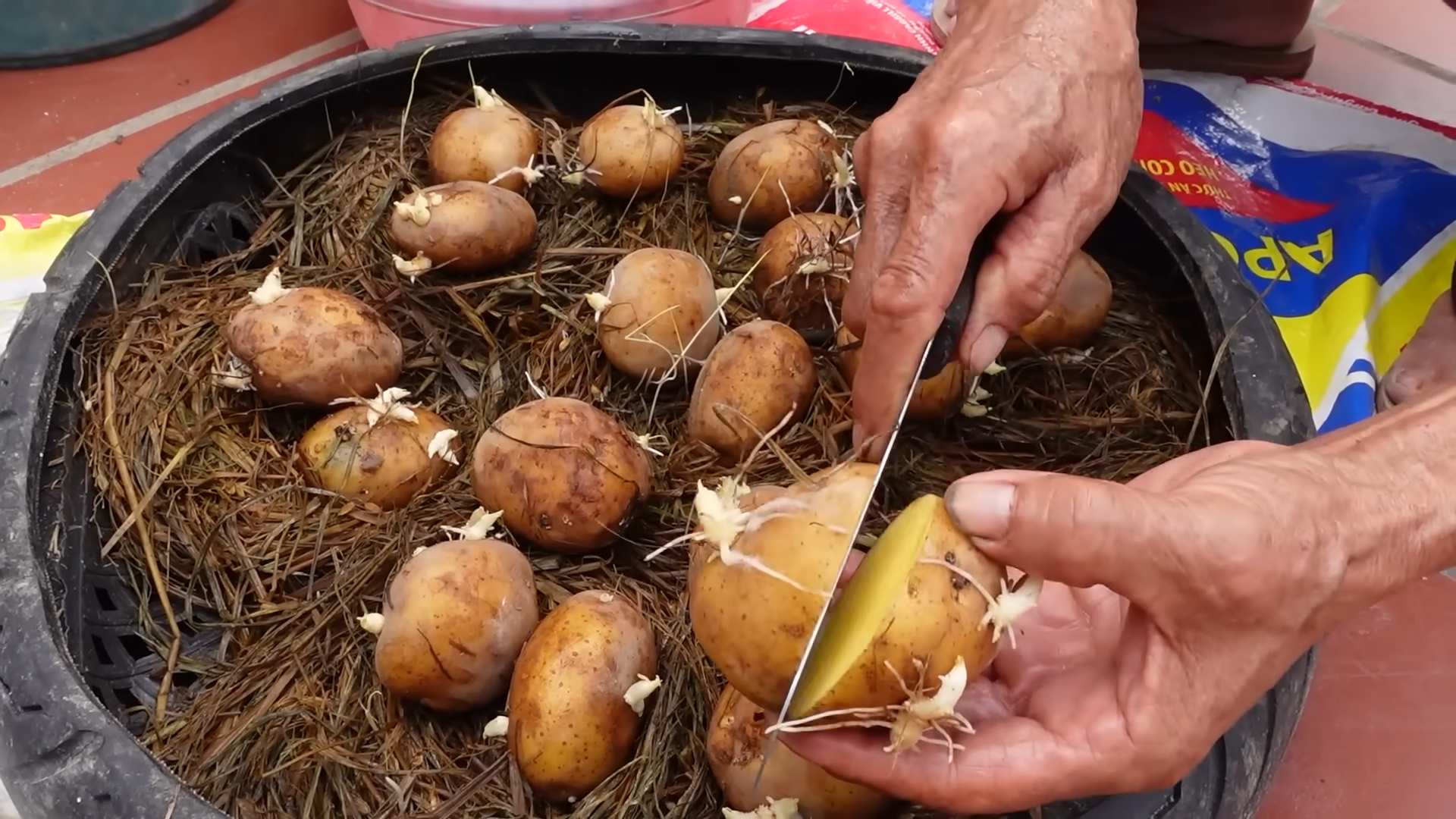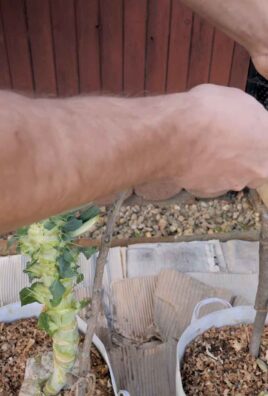Soil Free Potato Growing: Imagine harvesting a bounty of delicious potatoes without ever getting your hands dirty! Sounds like a dream, right? Well, it’s not! For centuries, innovative gardeners have been experimenting with alternative growing methods, and now, I’m thrilled to share a game-changing DIY trick that will revolutionize your potato harvest.
While traditional potato farming has deep roots in agricultural history, dating back thousands of years to the Andes Mountains, the beauty of soil free potato growing lies in its accessibility and adaptability. You don’t need acres of land or specialized equipment. This method is perfect for urban dwellers, apartment gardeners, or anyone looking to maximize their yield in a limited space.
Let’s face it, traditional gardening can be tough. Dealing with soil-borne pests, weeds, and the sheer back-breaking labor can be discouraging. That’s where this DIY hack comes in. By eliminating the soil, we eliminate many of these common problems, making potato growing easier, cleaner, and more rewarding. Plus, it’s a fantastic way to recycle materials and reduce your environmental footprint. So, are you ready to ditch the dirt and discover the magic of soil-free potatoes? Let’s get started!

Growing Potatoes Without Soil: A Fun and Easy DIY Project!
Hey there, fellow gardening enthusiasts! Ever thought about growing potatoes without getting your hands dirty in soil? It sounds crazy, right? But trust me, it’s totally doable and a super fun experiment. I’m going to walk you through how to grow potatoes in a container using just water and some basic supplies. Get ready for a surprisingly rewarding gardening adventure!
What You’ll Need
Before we dive in, let’s gather everything you’ll need. This is a pretty low-cost project, which is always a plus!
* Seed Potatoes: These are potatoes specifically grown for planting. You can find them at your local garden center or online. Look for varieties that are known to do well in containers. I personally love using Yukon Gold or Kennebec.
* A Large Container: Think big! You’ll need a container that’s at least 10 gallons in size. A plastic storage tote works great, or even a large bucket. Make sure it’s opaque to prevent algae growth.
* Water: Good old tap water will do just fine.
* Fertilizer: A liquid fertilizer specifically formulated for vegetables is essential. I recommend a balanced fertilizer like 20-20-20, diluted to half strength.
* Net Pots or Small Containers: These will hold the seed potatoes and allow the roots to grow into the water. 3-4 inch net pots are perfect.
* Clay Pebbles or Hydroton: These provide support and aeration for the roots in the net pots.
* Air Pump and Air Stone (Optional but Recommended): This will oxygenate the water, promoting healthier root growth and preventing anaerobic conditions.
* pH Meter (Optional): Monitoring the pH of the water can help ensure optimal nutrient uptake. The ideal range is between 5.5 and 6.5.
* Grow Lights (Optional): If you don’t have a sunny spot, grow lights will be necessary.
Preparing Your Seed Potatoes
Okay, let’s get those seed potatoes ready! This step is crucial for getting a good start.
1. Chitting (Sprouting): This is the process of encouraging sprouts to grow on your seed potatoes before planting. Place your seed potatoes in a cool, bright location for a week or two. You’ll notice small “eyes” or sprouts starting to form. This gives them a head start.
2. Cutting (Optional): If your seed potatoes are large, you can cut them into smaller pieces, ensuring each piece has at least one or two “eyes.” Let the cut surfaces dry for a day or two to prevent rotting. I usually skip this step if my seed potatoes are on the smaller side.
Setting Up Your Hydroponic Potato System
Now for the fun part – building our soil-free potato haven!
1. Prepare the Container: Clean your container thoroughly with soap and water. This will help prevent any unwanted bacteria or fungi from taking hold.
2. Place the Net Pots: Arrange the net pots or small containers on top of the container. You can use a piece of sturdy mesh or a plastic lid with holes cut in it to support the net pots. The bottom of the net pots should be submerged in the water.
3. Fill the Net Pots: Fill each net pot with clay pebbles or Hydroton. This will provide support for the seed potatoes and allow the roots to breathe.
4. Add the Seed Potatoes: Place one seed potato (or a piece of seed potato with sprouts) in each net pot, with the sprouts pointing upwards.
5. Add Water: Fill the container with water until it reaches the bottom of the net pots. The water should just touch the bottom of the seed potatoes.
6. Add Fertilizer: Mix your liquid fertilizer with the water according to the package instructions, but use half the recommended strength. Remember, we’re aiming for a balanced nutrient solution.
7. Install Air Pump and Air Stone (Optional): If you’re using an air pump, place the air stone at the bottom of the container and connect it to the air pump. This will oxygenate the water and promote healthy root growth.
Caring for Your Soil-Free Potato Plants
Alright, the system is set up! Now it’s time to nurture those potato plants.
1. Light: Potatoes need plenty of light, at least 6-8 hours per day. If you’re growing indoors, use grow lights. Position the lights about 6-12 inches above the plants.
2. Water Level: Monitor the water level regularly and add more water as needed to keep the bottom of the net pots submerged.
3. Nutrient Solution: Change the nutrient solution every 1-2 weeks. This will prevent the buildup of salts and ensure your plants are getting the nutrients they need.
4. pH Level (Optional): If you’re using a pH meter, check the pH of the water regularly and adjust it as needed to maintain a level between 5.5 and 6.5. You can use pH up or pH down solutions to adjust the pH.
5. Temperature: Potatoes prefer cooler temperatures, ideally between 60-70°F (15-21°C).
6. Hilling (Simulated): In traditional potato growing, you “hill” the plants by adding more soil around the stems as they grow. This encourages more potato production along the stem. Since we’re growing in water, we can simulate this by gradually lowering the water level as the plants grow. This will encourage the roots to grow further down the stem, potentially leading to more potatoes. Lower the water level in small increments, about an inch or two at a time.
7. Pest Control: Keep an eye out for pests like aphids or spider mites. If you spot any, treat them with an organic insecticide like neem oil.
Harvesting Your Soil-Free Potatoes
The moment we’ve all been waiting for! Harvesting time!
1. Timing: Potatoes are typically ready to harvest about 80-100 days after planting. You’ll know they’re ready when the foliage starts to turn yellow and die back.
2. Harvesting: Carefully lift the plants out of the container. You should find potatoes growing along the roots. Gently remove the potatoes from the roots.
3. Curing: After harvesting, cure the potatoes by placing them in a cool, dark, and well-ventilated place for a week or two. This will help them develop a thicker skin and improve their storage life.
Troubleshooting
Even with the best planning, things can sometimes go wrong. Here are a few common issues and how to address them:
* Yellowing Leaves: This could be a sign of nutrient deficiency. Make sure you’re using a balanced fertilizer and changing the nutrient solution regularly.
* Slow Growth: This could be due to insufficient light or temperature. Make sure your plants are getting enough light and that the temperature is within the ideal range.
* Root Rot: This is caused by anaerobic conditions. Make sure you’re using an air pump and air stone to oxygenate the water.
* Algae Growth: This can be prevented by using an opaque container and keeping the system clean.
Tips for Success
Here are a few extra tips to help you succeed with your soil-free potato growing adventure:
* Start with Healthy Seed Potatoes: Choose seed potatoes that are firm and free from disease.
* Use Filtered Water: If your tap water is heavily chlorinated, consider using filtered water.
* Monitor the pH Regularly: Maintaining the correct pH is crucial for nutrient uptake.
* Be Patient: Growing potatoes takes time. Don’t get discouraged if you don’t see results immediately.
* Experiment: Try different potato varieties and growing techniques to see what works best for you.
Growing potatoes without soil is a fascinating and rewarding experience. It’s a great way to learn about hydroponics and enjoy fresh, homegrown potatoes. So, give it a try and see what you can grow! Happy gardening!

Conclusion
So, there you have it! Growing potatoes without soil might sound like something out of a science fiction movie, but it’s surprisingly simple, incredibly rewarding, and a fantastic way to get fresh, homegrown potatoes even if you’re short on space or dealing with poor soil conditions. This method truly revolutionizes the way we think about potato cultivation.
Why is this DIY trick a must-try? Because it offers a multitude of benefits that traditional soil-based gardening simply can’t match. First and foremost, it’s incredibly space-efficient. You can grow a substantial amount of potatoes in a relatively small container, making it perfect for apartment dwellers, balcony gardeners, or anyone with limited yard space. Secondly, it eliminates the need for constant weeding and tilling, saving you time and effort. The controlled environment also minimizes the risk of soilborne diseases and pests, leading to healthier and more abundant harvests. Plus, let’s be honest, it’s just plain cool! Watching those potato plants thrive in a soilless medium is a fascinating and educational experience for gardeners of all ages.
But the real magic lies in the ease of harvesting. No more digging through mounds of dirt, hoping to unearth hidden treasures. With this method, you can simply reach in and pluck out the potatoes as they mature, leaving the plant to continue producing more. It’s a continuous harvest that provides a steady supply of fresh potatoes throughout the growing season.
Now, let’s talk about variations. While this guide focuses on using straw as the primary growing medium, you can experiment with other materials as well. Coconut coir, a byproduct of coconut processing, is an excellent alternative that provides good drainage and aeration. You can also try using a mixture of straw and compost for added nutrients. For those looking for a truly sustainable option, consider using shredded cardboard or newspaper as a base, although these materials will decompose more quickly and may require more frequent replenishment.
Another variation to consider is the type of container you use. While a large trash can or storage bin works well, you can also get creative with repurposed materials. Old tires stacked on top of each other, wooden pallets lined with plastic, or even burlap sacks can all be used to create a suitable growing environment. Just make sure the container is large enough to accommodate the growing potato plants and has adequate drainage.
Furthermore, you can tailor the nutrient solution to your specific needs. While a general-purpose fertilizer will work, you can also use a specialized potato fertilizer that is formulated to promote tuber development. Experiment with different nutrient ratios to see what works best for your plants. You can also add beneficial microbes to the growing medium to enhance nutrient uptake and improve plant health.
Don’t be afraid to experiment and adapt this method to your own unique circumstances. The beauty of DIY gardening is that there’s no one-size-fits-all approach. The most important thing is to have fun and learn from your experiences.
So, what are you waiting for? Grab a container, some straw, and a few seed potatoes, and get ready to embark on a soil-free potato growing adventure. We’re confident that you’ll be amazed by the results. And once you’ve harvested your first crop of homegrown potatoes, be sure to share your experience with us! We’d love to hear about your successes, your challenges, and any tips or tricks you’ve discovered along the way. Share your photos and stories on social media using #SoilFreePotatoes and let’s inspire others to give this innovative gardening method a try. Happy growing!
Frequently Asked Questions (FAQ)
What exactly are the benefits of growing potatoes without soil?
Growing potatoes without soil offers several advantages. It’s space-saving, ideal for urban gardeners or those with limited land. It reduces the risk of soilborne diseases and pests. Harvesting is easier, as you don’t need to dig through soil. It also minimizes weeding and tilling, saving time and effort. Finally, it’s a fascinating and educational experience, allowing you to observe root development and tuber formation more closely.
What kind of potatoes are best suited for soil-free growing?
Most potato varieties can be grown successfully without soil. However, early-maturing varieties like Yukon Gold, Red Norland, and Irish Cobbler tend to perform particularly well. These varieties have a shorter growing season, which makes them well-suited for container gardening. Experiment with different varieties to see which ones thrive best in your specific environment.
What kind of container should I use for soil-free potato growing?
The container should be large enough to accommodate the growing potato plants and have adequate drainage. A large trash can, storage bin, or even repurposed materials like old tires or wooden pallets can be used. The ideal size is at least 2 feet in diameter and 3 feet tall. Make sure the container is opaque to prevent sunlight from reaching the developing tubers, which can cause them to turn green and produce solanine, a toxic compound.
What kind of fertilizer should I use for soil-free potato growing?
A balanced, water-soluble fertilizer is recommended. Look for a fertilizer with an NPK ratio (nitrogen, phosphorus, potassium) of around 10-10-10 or 20-20-20. You can also use a specialized potato fertilizer that is formulated to promote tuber development. Follow the instructions on the fertilizer package for application rates and frequency. It’s important to avoid over-fertilizing, as this can lead to excessive foliage growth at the expense of tuber production.
How often should I water my soil-free potato plants?
Watering frequency will depend on the climate, the type of growing medium, and the size of the container. Generally, you should water the plants whenever the top inch of the growing medium feels dry to the touch. Avoid overwatering, as this can lead to root rot. Ensure that the container has adequate drainage to prevent water from accumulating at the bottom.
How do I know when to harvest my soil-free potatoes?
You can begin harvesting potatoes as soon as they reach a desirable size. For early-maturing varieties, this may be as soon as 60-70 days after planting. To harvest, simply reach into the container and pluck out the potatoes as they mature. The plant will continue to produce more potatoes as long as it is healthy and well-nourished. You can also harvest the entire plant at the end of the growing season by emptying the container and collecting all the remaining tubers.
Can I reuse the straw or other growing medium after harvesting my potatoes?
It’s generally not recommended to reuse the straw or other growing medium for growing potatoes again, as it may contain residual diseases or pests. However, you can compost the used growing medium and use it as a soil amendment in other parts of your garden.
What if my potato plants start to develop pests or diseases?
Monitor your plants regularly for signs of pests or diseases. If you notice any problems, take action immediately. Common potato pests include aphids, potato beetles, and flea beetles. Diseases include early blight, late blight, and potato scab. Treat pests with insecticidal soap or neem oil. Treat diseases with a fungicide. You can also prevent pests and diseases by providing your plants with optimal growing conditions, including adequate sunlight, water, and nutrients.
Can I grow potatoes without soil indoors?
Yes, you can grow potatoes without soil indoors, but you’ll need to provide them with adequate light. A sunny window or grow lights will be necessary. Indoor growing may also require more frequent watering and fertilization, as the plants will be growing in a more controlled environment.
Is soil-free potato growing organic?
Whether soil-free potato growing is organic depends on the materials and methods you use. If you use organic growing mediums, organic fertilizers, and organic pest control methods, then your soil-free potato growing can be considered organic.




Leave a Comment